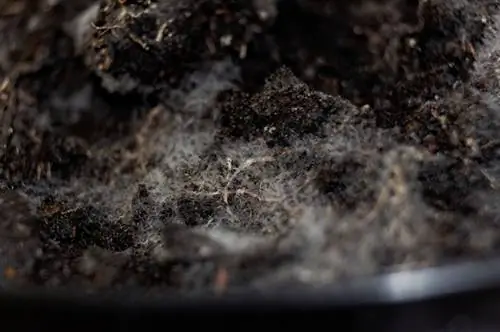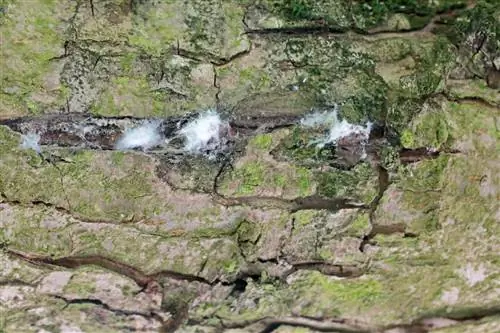- Author admin [email protected].
- Public 2023-12-16 16:46.
- Last modified 2025-01-23 11:20.
If a white coating spreads on the aerial roots and in the substrate, an orchid is affected by mold. If the pathogens are not stopped now, the floral existence will be at stake. Read here how you can effectively combat mold with simple measures.

How do you fight mold on orchids?
To combat mold on orchids, affected plants should be repotted and infected roots removed. A new culture pot, fresh orchid substrate and good drainage are important. Prevention can be achieved through regular spraying, adjusted watering and high humidity.
Repotting a moldy orchid - this is how it works
Mold on orchids cannot be controlled by simply cutting off the affected aerial roots and sorting out affected pieces of substrate. The pathogens are invisible to the human eye for a long time before they appear as a mealy-gray coating. We recommend quarantining the affected plant at the first signs and repotting it promptly. Follow these steps professionally:
- Unpot the moldy orchid by spraying the substrate with a sharp jet of water
- Using clean, freshly sharpened scissors or a scalpel, cut off the infected roots
- Take a new culture pot and fill it with a 1-2 cm high drainage made of expanded clay
- Pour a handful of fresh orchid substrate on top
Place the potted orchid into the fresh pine bark with a twisting motion. Then gradually add more substrate, occasionally knocking the pot onto the table to ensure complete distribution. Since mold could form due to excessive humidity, do not water or submerge the plant for the first few days. Only daily spraying with lime-free water provides the roots and leaves with the necessary moisture.
Tips for preventing mold
Mold spores feel comfortable wherever continuous moisture dominates. Since orchids still require high humidity, a good deal of sensitivity is required in this regard. You will deprive mold of its livelihood if you take the following aspects into account when caring for it:
- Spray aerial roots and leaves every 2-3 days
- Wate an orchid only when the substrate has dried thoroughly
- Ideally, immerse the root ball in soft, lukewarm water until no more air bubbles appear
- Always allow excess water to drain carefully before placing the culture pot in the planter
- Water sparingly in winter and spray more often
Simple humidifiers (€17.00 on Amazon), which are available inexpensively in stores, ensure the desired humidity of more than 50 percent. In winter, place a bowl filled with water on each active radiator. A bubbling indoor fountain or an aquarium in the room are also helpful. Simply fill an existing coaster with expanded clay and water.
Tip
If the leaves of an orchid are covered with a mealy-gray patina, it is most likely not mold, but rather the fungal infection mildew. Do not cut off the diseased foliage in the early stages. Instead, fight the disease with a mix of lime-free water and fresh milk in a 9:3 ratio. The solution is sprayed on the top and bottom surfaces every 2 days until the coating disappears.






